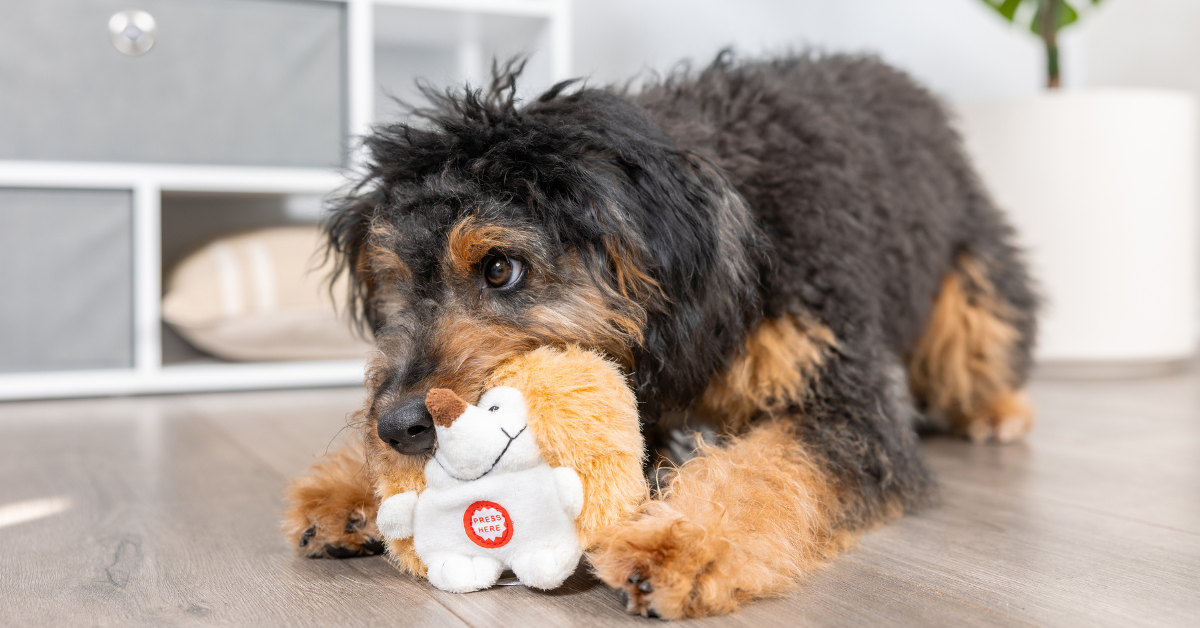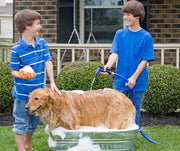Enjoy 20% OFF full-price travel & kennel must-haves with code THANKFUL20 at checkout!
Promo ends 11/21 at Midnight CST. Cannot be combined with other discounts.
Dogs & Their Plush Toy Obsession

If you're a dog owner, you’ve probably noticed your pup’s obsession with their plush toys. Many dogs have a favorite toy they carry around, sleep with, or even protect from other dogs. This behavior isn't just cute—it's deeply rooted in their natural instincts. From stuffed animals to squeaky toys, the types of toys dogs love vary widely. But the obsession remains the same.
This article will go over what their behavior means when to allow the use of them, and which plush toy will be great for your dog.
Fascination with Plush Toys
Dogs' fascination with plush toys can be attributed to several factors:
Instinctual Behavior
Many dogs have a strong prey drive, an instinctive behavior inherited from their wild ancestors. Plush toys can mimic the texture and appearance of prey animals, triggering a dog's natural hunting instincts.
Comfort and Security
Plush toys can provide comfort and security, similar to how a child might feel about a favorite stuffed animal. The toy's soft texture and familiarity can be soothing, especially for dogs experiencing anxiety or stress.
Play and Mental Stimulation
Dogs need mental and physical stimulation to stay happy and healthy. Plush toys can serve as play tools, helping keep a dog's mind active and engaged. Chewing, tossing, and playing with these toys can be a fun and rewarding activity.
Teething Relief
For puppies, plush toys can offer relief during teething. The soft yet chewable material helps soothe their gums as they go through the teething process.
Bonding and Interaction
Dogs often use toys to interact with their owners or other dogs. Plush toys can be a medium for games like fetch or tug-of-war, fostering bonding and social interaction.
Mimicking Nurturing Behavior
Some dogs exhibit nurturing behaviors toward their plush toys, treating them like puppies. This can be especially common in female dogs, who might carry the toy around and cuddle with it.
them, that is perfectly normal.
Choosing the Right Plush Toy for Your Dog

Safety should be your top priority when selecting a plush toy for your dog. Make sure the toy is made from non-toxic materials and durable enough to withstand chewing. Consider the size, too. Small toys can pose a choking hazard, especially for larger breeds.
Types of Plush Toys
There are several types of plush toys available, each serving different purposes:
- Squeaky Toys: These are great for dogs that enjoy auditory stimulation. The squeak can mimic the sounds of prey, appealing to your dog’s natural hunting instincts.
- Stuffed Animals: Soft and cuddly, these toys are perfect for dogs carrying around or snuggling with their toys.
- Interactive Toys: Designed to engage your dog's mind, these toys often incorporate hidden treats or moving parts to keep your dog entertained and mentally stimulated.
Age and Breed-Specific Recommendations
- Puppies: Look for plush toys that are soft yet durable. Puppies have softer teeth, so toys shouldn't be too hard. A stuffed animal or soft toy can be a great companion for a puppy.
- Small Breeds: Smaller breeds may prefer plush toys that are lightweight and easy to carry. Squeaky toys or small stuffed animals can be ideal.
- Large Breeds: For bigger dogs, choose larger, more durable toys. These dogs have stronger jaws and can easily tear through flimsy toys, so look for robust materials.
- Active Dogs: Dogs that enjoy a lot of playtime may benefit from interactive toys that provide both physical and mental stimulation. Tug-of-war toys can also be great for active play.
Specific Considerations
- If your dog is a heavy chewer, opt for plush toys designed to be chew-resistant. Avoid toys with small parts that can be swallowed.
- A soft, comforting plush toy can help soothe a dog that suffers from separation anxiety. Stuffed animals that mimic the feeling of a companion can be especially reassuring.
- If your dog exhibits resource-guarding behavior, be cautious with plush toys. Monitor their play to ensure it doesn’t lead to aggressive behavior.
Safety Tips
- Regular Inspection: Check the toy for any signs of wear and tear. If the toy is damaged, it's time to replace it to prevent choking hazards.
- Appropriate Size: Ensure the toy is appropriately sized for your dog to prevent choking. A toy that's too small can be easily swallowed.
- Non-Toxic Materials: Always choose toys made from non-toxic materials to ensure they are safe if your dog chews or ingests part of the toy.
How to Introduce Plush Toys To Your Dog

Introducing plush toys to your dog can be a fun and rewarding experience for you and your furry friend. Here's a simple, step-by-step guide to make the introduction smooth and enjoyable.
Step 1: Choose the Right Dog Toy
Pick a plush toy appropriate for your dog's size and chewing habits. Avoid toys with small parts that could be swallowed.
Step 2: Familiarize the Toy
Let your dog sniff and explore the toy while it's in your hand. Speak in a calm, encouraging tone to create a positive association.
Step 3: Controlled Play
Start with short play sessions. Throw the toy gently or use it for a gentle tug-of-war. Watch your dog's reaction and ensure they don't get too excited.
Step 4: Supervision is Key
Keep an eye on your dog during the initial play sessions. Ensure they don't tear the toy apart or eat any stuffing.
Step 5: Positive Reinforcement
Reward your dog with treats and praise when they play gently with the toy. This reinforces good behavior and helps them understand how to interact with the plush toy.
Step 6: Gradual Alone Time
Once your dog is comfortable with the toy, let them play with it alone for short periods. Gradually increase this time as they become more familiar with the toy.
Step 7: Regular Checks
Inspect the toy regularly for any signs of wear and tear. Replace it if it becomes damaged to prevent choking hazards.
What are the Best Plush Toys for My Dog?

When it comes to choosing the best plush toy for your dog, there are endless options to choose from. Petmate carries many plush dog toys from top pet brands like Zoobilee and FAT CAT—everything from fuzzy little animals to tough plush toys that can withstand chew time and playtime.
If your dog is known to shred their plush toys and remove the stuffing, the FAT CAT line of plush dog toys may be what you need for your dog. FAT CAT dog toys are available for all dog breeds of various sizes and characters. This brand of dog toys is unique in that most plush toys are machine washable and made from super-strong, durable canvas fabric with double stitching to keep your dog from ripping the toy apart. FAT CAT Terrible Nasty Scaries Dog Toy is the perfect example of a durable plush dog toy. Their durability yet soft design gives your dog a plush toy that will last for years.
If you are looking for a plush toy that is more cuddle-suited, check out Zoobilee's Plush dog toys. This brand specializes in snuggle buddies for dogs and offers all types of plush toy characters for your dog to cuddle up to. The Zoobilee Heggies is a puppy's favorite when it comes to snuggles. This plush toy is super soft, durable, and ready to grunt into your dog's life. Dogs love these one-of-a-kind characters, including Farmer, Fisherman, Chef, Princess, and more, for their grunting sounds and quirky companionship.
Best Toys For Your Dog's Play Style and Comfort Needs
Many dogs treat their plush toys as prey, engaging in play that mimics hunting and tug-of-war. Others see them as comforting objects, similar to how puppies may have relied on their mothers.
For pet parents, understanding their dog's behavior with toys can help them choose a suitable toy. A dog that likes to chew might benefit from sturdier toys, while a dog with separation anxiety might find comfort in a soft, cuddly plush toy because every dog is unique. It's important to consider your dog's behavior and preferences to help you pick the right toy.
For premium pet supplies that cater to your dog's needs, shop at Petmate today. Your furry friend deserves the best, and we’re here to help you provide it.
Previous article

Next article

Related posts
View all-

Top Travel Essentials for Pets This Holiday Season
Holiday travel often means bringing the whole family along, and for many of us, that includes our furry companions. Preparing for holiday pet travel is about more than just packing a bag; it's about ensuring your pet's safety, comfort, and happiness from the moment you leave home until you return. A little planning helps reduce stress for both you and your pet, making the journey a positive experience for everyone involved.
Read Article -

Best Leashes and Collars for Daily Walks: A Pet Parent’s Guide
A daily walk with your dog isn't just a chore—it's a chance to bond, explore, and stay active together. The right leash and collar can make every walk safer and more enjoyable for both of you. With numerous styles and materials available, it's essential to find gear that suits your dog's needs and your lifestyle.
Read Article -

Halloween Pet Safety: Keep Your Furry Friends Safe & Happy
Halloween brings excitement for families, but the spooky season can present unique challenges for our beloved pets. From toxic treats to overwhelming costumes, this festive time requires extra attention to ensure your furry companions stay safe, comfortable, and entertained throughout the celebrations.
Read Article



